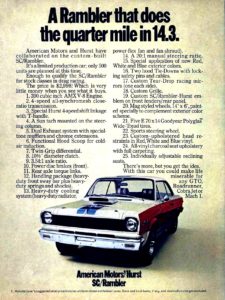
Although late to the party, some of AMC’s later muscle cars were impressive, like this 1969 advertisement for the AMC “Scrambler,” a 390-V8 powered, lightweight performer. (Compliments former AMC)
Q: Hello Greg and I am a big AMC fan. Looking back to your younger days, do you feel Rambler and AMC built formidable muscle cars of the era? Also, which of the muscle car AMC’s do you give the most respect to? Keep up the good work on these columns, especially on the muscle cars us baby boomers love. Thanks, Ken B., email from Florida.
A: Ken, to answer your main question, I do not feel AMC built formidable muscle cars during the heyday of the muscle car era, specifically 1964 to 1972.
Here’s why.
Hudson and Nash-Kelvinator merged in 1954 to form American Motors. Back then, AMC featured cars that were small and affordable, although never forgetting that the larger cars like the Ambassador were necessary to cater to those who wanted bigger cars. As for Hudson, AMC didn’t care one bit that this car dominated early NASCAR competition with its Fabulous Hudson Hornets. Nash? The new AMC directors also didn’t care one iota that Nash just happens to be NASCAR’s first ever corporate car sponsor.
(That’s strike one).
AMC dropped the ball again, as back in 1957, Chevy, Ford and MOPAR were building some powerful V8 engines while Rambler/AMC decided to continue concentrating on economical family cars.
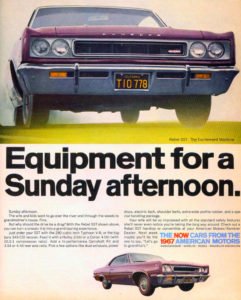
When AMC finally decided to build some muscle cars, its 1967 Rebel SST with a 343-inch V8 was no match in comparison to a 440 GTX, SS396 or a Shelby Mustang. (Compliments former AMC)
However, something slipped through AMC’s build process that became big news. Turns out AMC was sitting on a real high-performance performer with its 1957 Rambler Rebel 327-V8. This engine produced 255-horses with a four-barrel and 288-horses with Bendix fuel injection.
Sadly, status as a “performance car” instead of a family car went against the company dogma. AMC clearly had one of the fastest cars on the highway, but the corporate big wigs at AMC would have none of it. So, in a move to protect its family economy car image, AMC quickly announced that the 1957 Rebel fuel injection option was cancelled in favor of the four-barrel carb instead.
(That’s strike two).
As we moved into the 1960 decade, by the time AMC released its pony and muscle car lineup during the latter part of the decade, they were way behind the movement that began with the 1964 GTO. It got so bad, and to offset any muscle car talk at board meetings, AMC released a newspaper advertisement that stipulated the only “race” they were interested in was the “human race.”
(And that’s strike three).
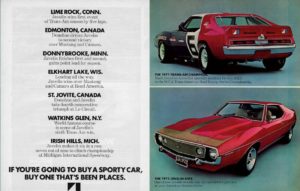
AMC finally hit the big time with its winning Trans Am Javelins, an operation run by Roger Penske. Mark Donohue brought AMC the overall championship in 1971, proving AMC was for real in the racing world. (Compliments former AMC)
As the muscle car era boomed, things changed at AMC’s think tank. Realizing the company was losing market share to the younger demographic consumer, AMC tried in 1967 to reverse its family car reputation. The sad truth was there were zero AMC muscle cars available to combat the Chevelle SS396, Buick GS400, Olds 442, Mustang GT/Shelby, Hemi GTX and 440 Dodge RT. They just plain missed the entire craze until it was too late.
I will, however, give a little bit of credit to the first Rambler Rebel SST “muscle car” I remember in 1967, featuring a 343-inch V8 and some high performance options like Carter 4-barrel carburetor, better camshaft, and even a 4:44 rear end gear. Still, a 343-V8 in 1967 against a 440-V8 Dodge R/T or a 427 SS Impala just didn’t cut it. (Not even close).
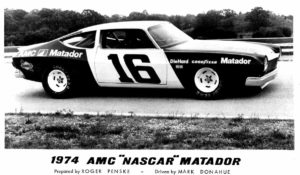
Even in NASCAR, Penske built AMC Matadors won races beginning in 1973 at Riverside, California. (Compliments former AMC)
A year later AMC got serious. The 1968 through 1972 Javelin/AMX models powered by the 390 Go-Pak and 401 engines are notable, as is the “real deal” AMC muscle car, namely the ‘69 Rambler Hurst SC. The Hurst SC was based on the light compact American body style powered by a 390-V8 with lots of factory high performance pieces. It ran very well and low 13-second quarter mile runs were easy with a few bolt-on additions.
Here’s another notable.
When AMC decided to go factory racing on a national scale, they did extremely well. The road racing Trans Am AMC Javelins deserve praise and began with a corporate OK in 1968 to field two Javelins. These Javelins ran against the Mustangs, Camaros, ‘Cudas and Challengers of the day, and with the likes of Roger Penske taking over the effort in 1970, it’s no surprise that an AMC Javelin with Mark Donohue behind the wheel won seven races and the 1971 overall Trans Am Championship. This proved that with the correct people (Penske/Donohue) AMC was fully capable of putting a winning car on the track.
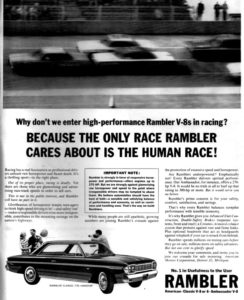
In 1964, AMC advertised nationally it was against competing in organized auto racing, which turned out to be a big mistake as the muscle car craze was beginning its boom years. (Compliments former AMC)
NASCAR, too, was “AMC/Penske initiated.” The surprising AMC Penske/Donohue factory effort began with research and development in 1971, and the end result was the winning AMC Matador that competed in the 1973 to 1975 NASCAR Cup seasons. The Penske Matador initially won with Mark Donohue at the Riverside road course in 1973, and following Donohue’s untimely death after a Formula 1 accident, Bobby Allison won four more Cup point races, including the 1975 Darlington Southern 500.
Further, two factory AMC Hornets joined the touring NHRA Pro Stock drag racing field in 1974. Richard Maskin and Dick Aarons headed up the effort, building AMC engines from scratch for the two Hornets. One of them, driven by Wally Booth, won six races overall during a very popular period of Pro Stock racing from 1974 to 1976. Booth even won the U.S. Nationals in 1976 and then defeated teammate Dave Kanners in the final round of the 1976 NHRA World Finals.
In summary, this excellent AMC factory racing effort must not go unnoticed. And even though AMC’s NHRA Pro Stock and NASCAR efforts all took place when buying a muscle car had long since passed, the sales at dealerships were fairly good because of these winning race cars. (I know because I bought a brand new 1974 AMC Hornet X).
Thanks for your letter Ken, and as you can tell I always loved the AMC cars – late to the muscle car party or not.
(Greg Zyla is a syndicated auto columnist who welcomes reader questions and input on old cars and auto nostalgia at 303 Roosevelt St., Sayre, Pa. 18840 or email at greg@gregzyla.com)

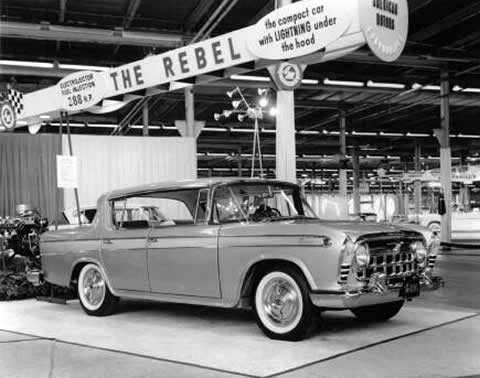

Be the first to comment on "Collector Car Corner – History of AMC muscle cars and racing: three strikes you’re out and too little too late"